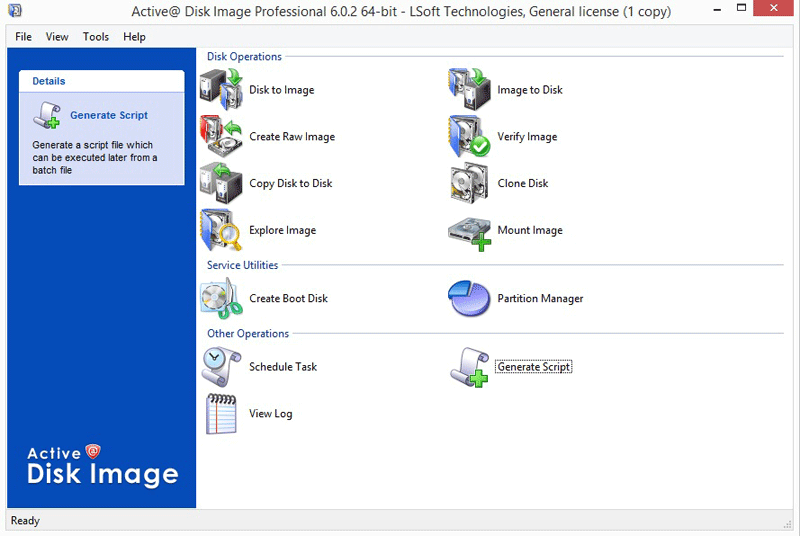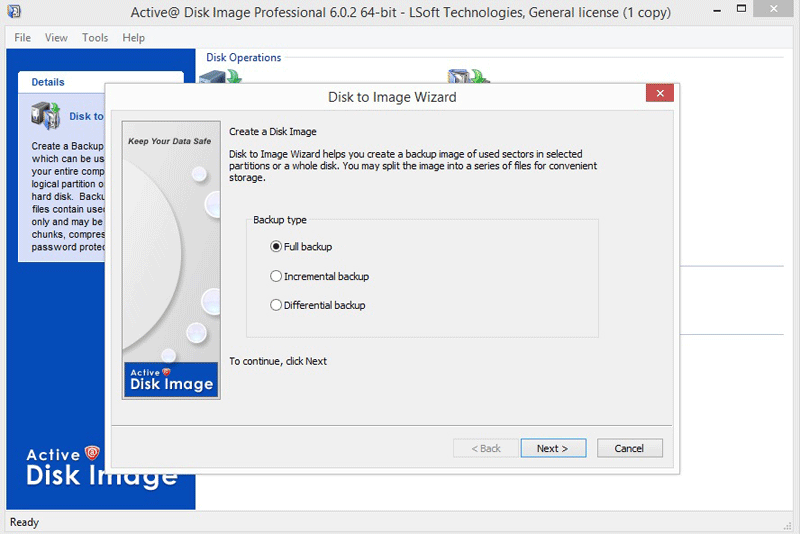
March 26 2015,
By Milos Milosevic,
technology blogger
Any PC user knows that the first thing after installing the fresh operating system is to back it up either creating its image or cloning it. Those who had trouble with persistent and indestructible malware know how much it can be painful when the only solution is to format main partition and install operating system all over again.
Although OS reinstallation takes around 10-15 minutes with modern operating systems and hardware it is still a great headache when you need to reinstall all of your programs from scratch and this can last a lot longer than a mere OS reinstall.
This also goes if you plan to install the same OS and applications on your second computer which, as you may imagine, can take forever.
Active@ Disk Image consists of quite a few mutually connected features:
The software also has Create Boot Disk options (which is a standard LSoft's package), and options for scheduling tasks and creating scripts for your future backups.
Pros: Variety of features that cover almost any occasion
Cons: Some functionalities are not very well explained, pricey ($69 for the Pro version)

Image to Disk backup is being performed by an intuitive wizard that will lead you every step of the way, although we do have some complaints. As soon as you start Disk to Image back up this is what you will see:

Unfortunately there are no hints or hovering messages in the wizard to let you know what do Full, Incremental and Differential backup actually mean?
If you start reading the manual some questions may be answered. As you might have guessed, Full backup means just what it says, a simple ordinary backup that will be used by the most. At the beginning it doesn't matter which backup you exactly choose since the first backup will always be the Full backup.
Incremental backup is based on the full backup or the other incremental backup and it contains only the differences and changes between those two backups.
The good side is that it doesn't require a lot of space and the bad side is that it requires the information from all of the previous incremental backups in order to be functional.
Differential backup on the other hand requires only two backups the first one (Full backup) and the last one.
Speaking in smaller scales there is no difference between Incremental and Differential backup when there are only two backups in either case, the difference is visible after a period of time.
The wizard later gets you to choose which drive you would like to backup, where do you want to store your backup as well as offering the option of encrypting it. There are also options of splitting the image into equal sized parts as well as creating multiple copies of the image you are about to create.
Create Raw Image — basically means that that the drive that you will get the exact same image of all the data in used and unused sectors. Of course there are no backup types here, and you also cant encrypt your raw image.
Cloning Disk is a more delicate operation and it presumes that every single sector from the drive you are about to backup will be recreated.
Copy Disk To Disk — is a very useful for all of us who at some point in time upgraded either from either smaller drive to a bigger one or from a HDD to SSD. This operation also supports changing the size of the copied partition making it a great tool for those who do upgrade.
Once you are done with creating your backup images you can verify them, restore them back, or even explore them
With all that in mind LSoft Technologies offers Active@ Disk Image, a tool that can copy and preserve the state of your partition and enable you to install it later on some other computer or resurrect it on the old one.
Active@ Disk Image has a lot of good sides.
It definitely does the job but some UI fixes should be implemented for those who don't want to grab the manual every now and then.
Price is something to consider, although it's not the cheapest product on the market it definitely is not the most expensive one, so some would say that its price maybe is a good measure.